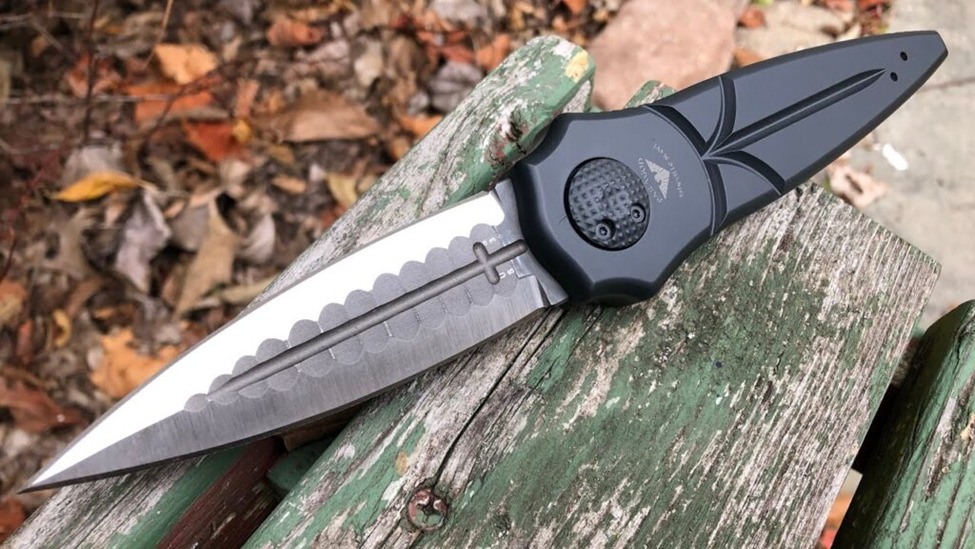Introduction: Gravity Knives – A Glimpse into an Enigmatic Blade
In the world of knives, there are various types, each with its unique design and purpose. One such intriguing category is gravity knives. These knives have a mystique about them, stemming from their unusual deployment mechanism and historical associations. In this article, we will delve into the mechanics, history, uses, and controversies surrounding gravity knives, shedding light on these enigmatic blades.
- Understanding Gravity Knives: The Basics
The Mechanism
Gravity knives are a distinct category of folding knives characterized by their unique deployment mechanism. Unlike traditional folding knives with a manual or assisted opening, gravity knives rely on the force of gravity to deploy the blade. The user holds the knife handle, presses a button, and with a flick of the wrist, the blade is released, locked into position.
Single-Handed Operation
One of the defining features of gravity knives is their one-handed operation. This design makes them practical for various applications, particularly in situations where the user needs to have one hand free while deploying the knife swiftly.
- A Historical Perspective: Origin and Evolution
Military Roots
Gravity knives have deep-rooted military origins. They were initially developed during the early 20th century, primarily for military use. These knives were designed to be easily carried by paratroopers and other military personnel who needed a reliable and quick-deploying blade in the field. Their compact size and one-handed operation made them ideal for a range of tasks.
World War II and Beyond
The prominence of gravity knives increased during World War II, with various nations adopting them for their armed forces. These knives proved invaluable for cutting parachute lines and other utility tasks on the battlefield. After the war, their design evolved, and they began to find their way into civilian markets.
- Legal Ambiguity and Controversy
The Legal Conundrum
Despite their practicality and historical significance, gravity knives have often been shrouded in legal ambiguity and controversy, particularly in the United States. Their unique deployment mechanism, which involves a button release and gravity-assisted opening, has led to varying interpretations of their legality in different jurisdictions.
New York City’s Strict Interpretation
One of the most infamous cases of gravity knife controversy is in New York City. The city’s strict interpretation of gravity knife laws resulted in the arrest and prosecution of individuals carrying common folding knives that could be opened with a “wrist-flick.” Critics argued that the laws were overly broad and that they disproportionately affected construction workers and other tradespeople who relied on such tools for their work.
Legal Reforms and Advocacy
In response to these controversies, advocacy groups and legal experts have pushed for reforms in knife laws. The goal has been to clarify the legal definitions of gravity knives to prevent unjust prosecutions of individuals carrying everyday tools.
- Modern Uses and Variations
Everyday Carry (EDC) Knives
In recent years, gravity knives have found their place among everyday carry (EDC) enthusiasts. Modern gravity knives are designed with improved locking mechanisms and materials, making them reliable and durable for everyday tasks. They offer quick deployment and one-handed operation, making them a popular choice for those seeking a versatile EDC knife.
Tactical and Rescue Applications
Gravity knives have also been adopted for tactical and rescue applications. Law enforcement and first responders appreciate their swift deployment and reliability in critical situations. These knives often feature serrated edges and glass-breaking tips for emergency use.
- The Legal Landscape Today
Varied State Laws
The legal status of gravity knives varies from state to state in the United States, contributing to ongoing legal debates and confusion. While some states have clarified their knife laws to distinguish gravity knives from other folding knives, others continue to have vague or ambiguous statutes.
Federal Impact
In 2020, the Federal Switchblade Act was amended to exclude assisted-opening knives from the definition of “switchblade.” This change clarified that assisted-opening knives, which include some gravity knives, are not considered switchblades under federal law. However, individual state laws may still apply.
- Notable Gravity Knife Models
Victorinox Swiss Army Knives
Victorinox, the renowned Swiss knife manufacturer, has produced a gravity knife version of their iconic Swiss Army Knife. These knives feature the classic multi-tool design with various folding blades and tools, all deployable with one hand. They are known for their quality and versatility.
German Paratrooper Gravity Knife
The German Paratrooper Gravity Knife is one of the most recognizable models in military history. It features a unique folding design with a bayonet blade, a can opener, and other tools. Originally issued to German paratroopers during World War II, this knife is now a sought-after collector’s item.
- The Future of Gravity Knives
Continued Innovation
As with all types of knives, gravity knives continue to evolve. Modern materials, such as advanced steels and lightweight handle materials, contribute to the durability and performance of these knives. Innovations in locking mechanisms and deployment systems enhance their reliability.
Legal Clarity and Advocacy
The legal status of gravity knives remains a topic of discussion and advocacy. Continued efforts to clarify and reform knife laws aim to prevent unjust prosecutions and ensure that individuals can carry and use these knives for legitimate purposes without fear of legal consequences.
- Historical Significance of Gravity Knives
World War II and Beyond
During World War II, the significance of gravity knives became even more pronounced. Several nations, including the United States and Germany, adopted these knives for their armed forces. Paratroopers, in particular, found them to be invaluable tools. Gravity knives were used for a variety of tasks, including cutting parachute lines and other utility functions in the field.
Civilian Adoption
After the war, many military surplus gravity knives found their way into civilian hands. This marked the beginning of their popularity among outdoor enthusiasts, collectors, and everyday users. The knives’ compact size and ease of deployment made them suitable for a range of tasks, from camping to general utility work.
- Legal Ambiguity and Controversy
Legal Definitions
One of the central issues surrounding gravity knives has been the ambiguity in legal definitions. The unique deployment mechanism of these knives, involving a button release and gravity-assisted opening, has led to varying interpretations of their legality in different jurisdictions.
New York City’s Strict Interpretation
One of the most notorious instances of gravity knife controversy unfolded in New York City. The city’s strict interpretation of gravity knife laws resulted in the arrest and prosecution of individuals carrying common folding knives that could be opened with a “wrist-flick.” Critics argued that the laws were overly broad and that they disproportionately affected construction workers and other tradespeople who relied on such tools for their work.
Legal Reforms and Advocacy
In response to these controversies, advocacy groups and legal experts have pushed for reforms in knife laws. The goal has been to clarify the legal definitions of gravity knives to prevent unjust prosecutions of individuals carrying everyday tools. Some states have already taken steps to distinguish gravity knives from other types of folding knives.
- Modern Uses and Variations
Everyday Carry (EDC) Knives
In recent years, gravity knives have experienced a resurgence in popularity, particularly among everyday carry (EDC) enthusiasts. Modern gravity knives are designed with improved locking mechanisms and materials, making them reliable and durable for everyday tasks. They offer quick deployment and one-handed operation, making them a popular choice for those seeking a versatile EDC knife.
Tactical and Rescue Applications
Gravity knives have also been adopted for tactical and rescue applications. Law enforcement and first responders appreciate their swift deployment and reliability in critical situations. These knives often feature serrated edges and glass-breaking tips for emergency use.
- The Legal Landscape Today
Varied State Laws
The legal status of gravity knives varies significantly from state to state in the United States, contributing to ongoing legal debates and confusion. While some states have clarified their knife laws to distinguish gravity knives from other folding knives, others continue to have vague or ambiguous statutes.
Federal Impact
In 2020, the Federal Switchblade Act was amended to exclude assisted-opening knives from the definition of “switchblade.” This change clarified that assisted-opening knives, which include some gravity knives, are not considered switchblades under federal law. However, individual state laws may still apply and can sometimes be stricter than federal regulations.
- Notable Gravity Knife Models
Victorinox Swiss Army Knives
Victorinox, the renowned Swiss knife manufacturer, has produced a gravity knife version of their iconic Swiss Army Knife. These knives feature the classic multi-tool design with various folding blades and tools, all deployable with one hand. They are known for their quality and versatility, making them popular choices among outdoor enthusiasts and adventurers.
German Paratrooper Gravity Knife
The German Paratrooper Gravity Knife is one of the most recognizable models in military history. It features a unique folding design with a bayonet blade, a can opener, and other tools. Originally issued to German paratroopers during World War II, this knife is now a sought-after collector’s item, cherished for its historical significance and functionality.
- The Future of Gravity Knives
Continued Innovation
As with all types of knives, gravity knives continue to evolve. Modern materials, such as advanced steels and lightweight handle materials, contribute to the durability and performance of these knives. Innovations in locking mechanisms and deployment systems enhance their reliability and make them suitable for various applications.
Legal Clarity and Advocacy
The legal status of gravity knives remains a topic of discussion and advocacy. Continued efforts to clarify and reform knife laws aim to prevent unjust prosecutions and ensure that individuals can carry and use these knives for legitimate purposes without fear of legal consequences.

Conclusion: Gravity Knives – A Unique Blade with a Complex Legacy
Gravity knives, with their distinctive deployment mechanism, historical significance, and legal controversies, occupy a unique place in the world of knives. They have evolved from military tools to everyday carry options, and their legal status continues to be a subject of debate and reform.
While gravity knives may always remain enigmatic due to their unconventional deployment method, their practicality and versatility make them valued tools for various applications. As advocates work towards legal clarity and responsible knife use, the future of gravity knives may see increased acceptance and recognition for their utility and historical significance. Whether you’re a collector, an enthusiast, or someone seeking a reliable tool for everyday use, gravity knives continue to intrigue and captivate those who appreciate their unique qualities.











